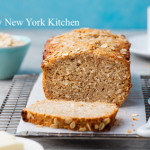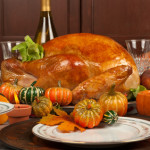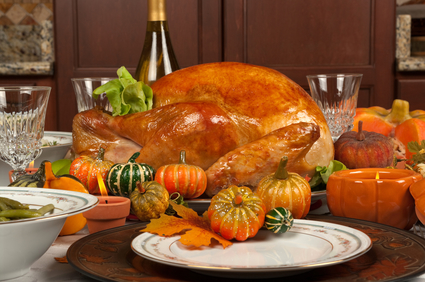Quick Breads
Quick Breads
For mouth-watering breads that don’t require a lot of time, turn to quick breads. By using baking powder, baking soda, steam, or air instead of yeast to leaven dough. An advantage of quick breads is their ability to be prepared quickly and reliably, without requiring time-consuming skilled labor and the climate control needed for traditional yeast breads. Quick breads include banana bread, beer bread, biscuits, cornbread, cookies, muffins, cakes, pancakes, brownies, scones, and soda bread.
Almost all quick breads have the same basic ingredients: Flour, leavening, eggs, fat (butter, margarine, shortening, or oil) and a liquid such as milk. Ingredients beyond these basics are added for variations of flavor and texture. The type of bread produced varies based predominantly on the method of mixing, the major flavoring, and the ratio of liquid in the batter. Some batters are thin enough to pour and others are thick enough to mold into lumps.
There are four main types of quick bread batter:
Pour Batters: Such as pancake batter, have a liquid to dry ration of about 1:1 and so pours in a steady stream – also called a “low-ratio” baked good.
Drop Batters: Such as cornbread and muffin batters, have a liquid to dry ratio of about 1:2.
Soft Doughs: Such as many chocolate chip cookie doughs, have a liquid to dry ratio of about 1:3. Soft doughs stick significantly to work surfaces.
Stiff Doughs: Such as pie crust and sugar cookie doughs, have a liquid to dry ratio of 1:8. Stiff doughs are easy to work in that they only minimally stick to work surfaces, including tools and hands – also called “high-ratio” baked goods.
Preparing a quick bread generally involves two mixing containers. On contains all dry ingredients (including chemical leavening agents or agent) and one contains all wet ingredients (possibly including liquid ingredients that are slightly acidic in order to initiate the leavening process). In some variations, the dry ingredients are in a bowl and the wet ingredients are heated sauces in a saucepan off-heat and cooled.
During the chemical leavening process, agents (one or more food-grade chemicals – usually a weak acid and a weak base) are added into the dough during mixing. These agents undergo a chemical reaction to produce carbon dioxide, which increases the baked good’s volume and produces a porous structure and lighter texture. Yeast breads often take hours to rise, and the resulting baked good’s texture can vary greatly based on external factors such as temperature and humidity. By contrast, breads made with chemical leavening agents are relatively uniform, reliable, and quick. Usually, the resulting baked good is softer and lighter than traditional yeast breads.
Chemical leavening agents include a weak base, such as baking soda (sodium bicarbonate) plus a weak acid, such as cream of tartar, lemon juice, or cultured buttermilk, to create an acid-base reaction that releases carbon dioxide. Quick bread leavened specifically with baking soda is often called “soda bread.” Baking powder contains both an acid and a base in dry powdered form, and simply needs a liquid medium in which to react. Other alternative leavening agents are egg whites mechanically beaten to form stiff peaks, as in the case of many waffle recipes, or steam, in the case of cream puffs.
There are three basic methods for making quick breads, which may combine the “rise” of the chemical leavener with advantageous “lift” from other ingredients.
The Stirring Method: Also known as the quick-bread method, blending method, or muffin method is used for pancakes, muffins, corn bread, dumplings, and fritters. This method calls for measurement of dry and wet ingredients separately, then quickly mixing the two. Often the wet ingredients include beaten eggs, which have trapped air that helps the product to rise. In these recipes, the fats are liquid, such as cooking oil. Using mixing is done using a tool with a wide head such as a spoon or spatula to prevent the dough from becoming over-beaten, which would break down the egg’s lift.
The Creaming Method: Frequently used for cake batters. The butter and sugar are “creamed” or beaten together until smooth and fluffy. Eggs and liquid flavorings are mixed in, and finally dry and liquid ingredients are added in. The creaming method combines rise gained from air bubbles in the creamed butter with the rise from the chemical leaveners. Gentle folding in of the final ingredients avoids destroying these air pockets.
The Shortening Method: Also known as the biscuit method, is used for biscuits and scones. This method cuts solid fat (whether lard, butter, or vegetable shortening) into flour and other dry ingredients using a food processor, pastry blender, or two hand-held forks. The layering from this process gives rise and adds flakiness as the fold of fat melts during baking. This technique is said to produce “shortened” cakes and breads, regardless of whether or not the chosen fat is vegetable shortening.
Quick bread originated in the United States at the end of the 18th century. Before the creation of quick bread, baked goods were leavened with either yeast or by mixing dough with eggs. The discovery of chemical leavening agents and their widespread military, commercial, and home utilization in the United States dates back to 1846 with the introduction of commercial baking soda in New York by Church and Dwight of “Arm & Hammer” fame. This development was extended in 1956 by the introduction of commercial baking powder in Massachusetts, although the best known form of baking powder is “Calumet”, which was first introduced in West Hammond and Hammond, Indiana (later Calumet City, Illinois) in 1889. Both forms of food-grade chemical leaveners are still being produced under their original names.
During the American Civil War (1861-1865) the demand for portable and quickly made food was high, while skilled labor for traditional bread making was scarce. This encouraged the adoption of bread, which was rapidly made and leavened with baking soda, instead of yeast. The shortage of chemical leaveners in the American South during the Civil War contributed to a food crisis.
As the Industrial Revolution accelerated, the marketing of mass-produced prepackaged foods was eased by the use of chemical leaveners, which could produce consistent products regardless of variations in source ingredients, time of year, geographical location, weather conditions, and many other factors that could cause problems with environmentally sensitive, temperamental yeast formulations. These factors were traded off against the loss of traditional yeast flavor, nutrition, and texture.
www.tinynewyorkkitchen.com
“Work With What You Got!”
© Victoria Hart Glavin Tiny New York Kitchen © 2016 All Rights Reserved
Thanksgiving Menu Guide
Thanksgiving Menu Guide
In the spirit of getting organized here is a Thanksgiving Menu guide that can help you plan according. Print this list out and add your own notes. Remember that the key to a successful Thanksgiving dinner is organization.
Soups & Starters
Italian Wedding Soup (Tiny Meatballs, Tortellini & Escarole)
Creamy Mushroom Soup (Rich Mushroom Broth With Sliced Mushrooms)
Sweet Potato Kale Soup (Sweet Potatoes, Corn & Peppers Simmered in Broth, Topped With Kale)
Butternut Squash Soup (Sweet Butternut Squash Simmered in a Light Vegetable Broth With Ginger & Mace)
Chicken Stock (Chicken Bones & Fresh Vegetables Simmered For Hours)
Wild Mushroom Strudel (Portabello, Shitake & Button Mushrooms Cooked With Garlic & Herbs Finished With a Mix of Goat, Mozzarella, Gruyere & Cream Cheese Wrapped In a Crispy Puff Pastry Shell
Bacon Wrapped Scallops (Sea Scallops Wrapped in Smoked Bacon)
Sides
Garlicky Greens (Steamed Kale & Chard Seasoned with Roasted Garlic)
Roasted Brussels Sprouts (Roasted Brings Out Their Natural Sweetness)
Green Beans With Almonds (Fresh Green Beans With Sliced Crisp Almonds With a Touch of Tarragon)
Creamed Spinach With Roasted Garlic (Spinach Seasoned With Nutmeg & Tossed With Cream & Garlic)
Roasted Corn Pudding (A Savory American Classic)
Roasted Butternut Squash With Dried Cranberries (Squash, Roasted With Onions & Herbs)
Cornbread Stuffing With Sausage & Spinach (Sausage In Rustic Stuffing)
Traditional New England Stuffing (Moist Bread Stuffing With Herbs & Spices)
Classic Mashed Potatoes (Velvety Smooth Made With Cream & Butter)
Maple Bourbon Sweet Potatoes (Mashed Sweet Potatoes Sweetened With a Bourbon Maple Syrup
Home-style Green Beans (Fresh Green Beans With Cherry Tomatoes)
Apple Fennel Slaw (Granny Smith Apples, Horseradish & Fennel)
Green Salad (Mixed Green Salad With Cider Dressing)
Sweet & Sour Cabbage (Red Cabbage Braised in Duck Fat)
Peas With Pearl Onions (3 Types of Peas With Pearl Onions)
Autumn Vegetable Ragout With Soft Polenta (Vegetables & Polenta)
Roasted Beets With Orange Vinaigrette (Warm Roasted Beets With Orange Dressing)
Celery Root Salad
Warm Spinach Salad With Goat Cheese & Apples
Sweet Potato & Banana Puree
Apple Bacon Cornbread Stuffing
Mashed Potatoes And Parsnips With Crisp Root Vegetable Strips
Roasted Cauliflower And Shallots With Chard & Dukkah
Brussels Sprouts and Wheat Berry Slaw With Smoked Paprika Dressing
Rich Turkey Gravy (Smooth With Deep Roasted Flavor)
Vegan Wild Mushroom Gravy (Deep, Robust Flavor From Wild Mushrooms and a Splash of White Wine)
Organic Cranberry Orange Relish (Organic Whole Berry Relish With Orange & a Touch of Cinnamon)
Brandied Cranberry Sauce With Pecans (Whole Cranberries Cooked With Pecans, Brandy & Sugar)
Main Attraction
Organic Whole Turkey (Brined or Un-brined)
Roast Turkey With Sage Butter
Cherry Glazed Turkey
Turkey Breast
Orange Pecan Cornish Hens
Vegetarian Eggplant Parmesan
Breads
Family Style Cornbread
Parker House Rolls
Boston Brown Bread
Parmesan Garlic Biscuits
Popovers
Desserts
Pumpkin Pie
Apple Pie
Blueberry Pie
Cherry Pie
Pecan Pie
Apple Crumb Pie
Carrot Cake
Pumpkin Cake
Maple Bread Pudding
Cranberry Pear Crisp
Black Mission Fig Tart
Assorted Cookies
Make Ahead Items
Many Thanksgiving dishes or parts of dishes can be made in advance which is a big help. After writing out your menu and shopping lists look to see what can be done ahead of time.
Most soups can be made 1 or 2 days before serving.
Most appetizers (or parts of them) can be made 1 day before serving.
Roux for gravy can be made several hours before using. Just mix butter and flour together, reheat and add stock and pan drippings when time to make gravy.
Vegetables can be chopped 1 or 2 days before using.
Grate cheese or spices 1 to 2 days before using.
Wash, dry, and wrap lettuce in paper towels, and store in a ziplock bag. Place in the refrigerator until ready to toss 1 day before serving.
Most salad dressings can be made 1 to 2 days before serving.
Have turkey as prepped as possible (salted, spiced and rubbed with butter, in its pan) and ready to go in the oven.
Stuffing items such as onions, celery, mushrooms, etc can be cooked 1 day before combining with bread and stuffed into the turkey.
Bread for stuffing can be cut up the day ahead and stored in a paper bag. Dried out bread is the best for stuffing.
Desserts or parts of desserts can often be made 1 to 2 days ahead such as sauces, crusts, pie filings or toppings.








